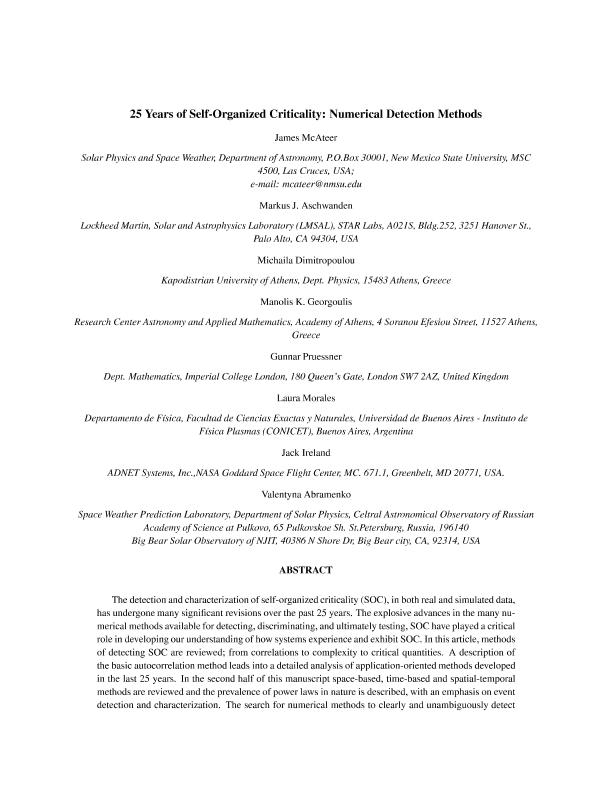Artículo
25 Years of Self-organized Criticality: Numerical Detection Methods
McAteer, James; Aschwanden, Markus J.; Dimitropoulou, Michaila; Georgoulis, Manolis K.; Pruessner, Gunnar; Morales, Laura Fernanda ; Ireland, Jack; Abramenko, Valentyna
; Ireland, Jack; Abramenko, Valentyna
 ; Ireland, Jack; Abramenko, Valentyna
; Ireland, Jack; Abramenko, Valentyna
Fecha de publicación:
05/2015
Editorial:
Springer
Revista:
Space Science Reviews
ISSN:
0038-6308
Idioma:
Inglés
Tipo de recurso:
Artículo publicado
Clasificación temática:
Resumen
The detection and characterization of self-organized criticality (SOC), in both real and simulated data, has undergone many significant revisions over the past 25 years. The explosive advances in the many numerical methods available for detecting, discriminating, and ultimately testing, SOC have played a critical role in developing our understanding of how systems experience and exhibit SOC. In this article, methods of detecting SOC are reviewed; from correlations to complexity to critical quantities. A description of the basic autocorrelation method leads into a detailed analysis of application-oriented methods developed in the last 25 years. In the second half of this manuscript space-based, time-based and spatial-temporal methods are reviewed and the prevalence of power laws in nature is described, with an emphasis on event detection and characterization. The search for numerical methods to clearly and unambiguously detect SOC in data often leads us outside the comfort zone of our own disciplines—the answers to these questions are often obtained by studying the advances made in other fields of study. In addition, numerical detection methods often provide the optimum link between simulations and experiments in scientific research. We seek to explore this boundary where the rubber meets the road, to review this expanding field of research of numerical detection of SOC systems over the past 25 years, and to iterate forwards so as to provide some foresight and guidance into developing breakthroughs in this subject over the next quarter of a century.
Palabras clave:
Numerical Methods
,
Self Organized Criticality
Archivos asociados
Licencia
Identificadores
Colecciones
Articulos(INFINA)
Articulos de INST.DE FISICA DEL PLASMA
Articulos de INST.DE FISICA DEL PLASMA
Citación
McAteer, James; Aschwanden, Markus J.; Dimitropoulou, Michaila; Georgoulis, Manolis K.; Pruessner, Gunnar; et al.; 25 Years of Self-organized Criticality: Numerical Detection Methods; Springer; Space Science Reviews; 198; 1-4; 5-2015; 217-266
Compartir
Altmétricas



